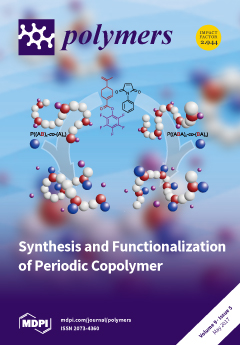This work reports the effect of different amounts of ceria nanoparticles on UV resistance and barrier properties of water-based polyurethane (WPU) on glass and AA7075 aluminum alloy substrates. Hybrid coatings were synthesized from an aliphatic WPU–HDI (1,6-hexamethylene di-isocyanate) and cerium oxide nanoparticles (CeO
[...] Read more.
This work reports the effect of different amounts of ceria nanoparticles on UV resistance and barrier properties of water-based polyurethane (WPU) on glass and AA7075 aluminum alloy substrates. Hybrid coatings were synthesized from an aliphatic WPU–HDI (1,6-hexamethylene di-isocyanate) and cerium oxide nanoparticles (CeO
2) with an average particle size distribution of about 25 nm. Different nanoceria amounts (1, 3 and 5 wt %), mixing times (30, 60 and 120 min) and methods to disperse the nanostructures into the polymer matrix (magnetic stirring and sonication) were evaluated. Initially, the dispersion of CeO
2 nanoparticles embedded in the polymer matrix and displacement in the corrosion potential (
Ecorr) were analyzed by confocal scanning laser microscopy (CLSM) and open circuit potential (
Eocp) measurements. According to this behavior, the dispersion and water ratio required during the polymerization process were established. Coated samples obtained after the second stage were characterized by X-ray diffraction (XRD), scanning electron microscopy (SEM), atomic force microscopy (AFM) and optical light microscopy. In addition, optical measurements on glass substrates were evaluated with UV-vis spectroscopy. The effect of the synthesis parameters on the corrosion behavior of WPU–CeO
2/AA7075 systems was investigated with
Eocp and electrochemical impedance spectroscopy (EIS) in a 3 wt % NaCl solution. In addition, the films were subjected to 180 h of accelerated weathering. The results show that the combination of specific nanoceria addition with the optimal synthesis parameters enhances optical transparence of WPU as well as barrier properties. From these, the coated specimens prepared with 3 wt % of ceria content and sonicated for 30 min showed a highly dispersed system, which results in a high charge transfer resistance. The observed properties in clear coats deposited on metallic substrates suggested an improvement in the appearance and less deterioration in UV exposure in comparison with pure WPU, enhancing the protective properties of the AA7075 aluminum alloy when exposed to a corrosive medium.
Full article






